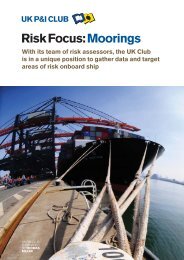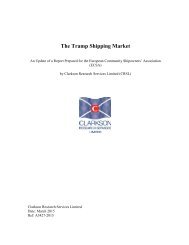Preparing cargo holds_ Loading solid bulk cargoes
Preparing cargo holds_ Loading solid bulk cargoes
Preparing cargo holds_ Loading solid bulk cargoes
You also want an ePaper? Increase the reach of your titles
YUMPU automatically turns print PDFs into web optimized ePapers that Google loves.
COMMON CAUSE OF CARGO DAMAGE<br />
Key Point: water ingress claims are still a major source of <strong>cargo</strong> related claims on <strong>bulk</strong> carriers.<br />
The Association sees this cause as one of the most common and recurring features of <strong>cargo</strong> claims, especially for the<br />
carriage of sensitive <strong>cargo</strong>es like grains, soyabeans and rice. Often it turns out that better maintenance and standards<br />
could have prevented very expensive claims. It is important to watch out for:<br />
´ ´ water ingress usually results from 3 sources:<br />
´ ´ Leaking hatch covers<br />
´ ´ Back-flow through bilge systems<br />
´ ´ Ballast tanks, including impact damage on structures, leaking manhole lids and in-adequate monitoring.<br />
´ ´ effective measures should be taken to monitor and test these particular areas of concern and defects must be<br />
identified and rectified as soon as possible.<br />
´ ´ additional water sources :<br />
´ ´ moisture from loading <strong>cargo</strong> that is wet or comes with a high moisture content<br />
´ ´ condensation or “sweating” that can come from a lack of ventilation or incorrect ventilation<br />
Skuld Case Study:<br />
A vessel carried a <strong>cargo</strong> of grain from North America to the Mediterranean, and on discharge very extensive water<br />
damage was found to have occurred in the top layers spread over a number of <strong>cargo</strong> <strong>holds</strong>. While the vessel did meet<br />
some poor weather on route, it was not exceptional. Instead testing revealed that the hatches were not water tight, and<br />
this meant it was not possible to effectively limit liability on the claim which exceeded a million dollars. The claim was<br />
entirely preventable.<br />
PRACTICAL ADVICE: DOING THE HOMEWORK<br />
Key Point: a thorough inspection must be carried out on completion of the preparation and before<br />
tendering a notice of readiness to load.<br />
It is much better to prevent a hold inspection failure than to have to deal with the cost and consequence of the vessel<br />
being rejected for loading. Some advance preparation can make all the difference:<br />
´ ´ the C/O should carry out an inspection of the <strong>cargo</strong> carrying spaces and equipment. He must view the inspection<br />
through the eyes of any potential pre-shipment surveyor/ inspector and apply rigorous checks accordingly;<br />
´ ´ during any pre-shipment survey, the Master or C/O must accompany the surveyor/inspector at all times and crew<br />
members should be standing-by ready to rectify any deficiencies noted;<br />
´ ´ regular checks should be made for the unwanted presence of insect infestation, larvae and eggs, animals and<br />
animal droppings, sewage or odours. It is important to check all areas of the <strong>holds</strong>;<br />
PAGE 11




